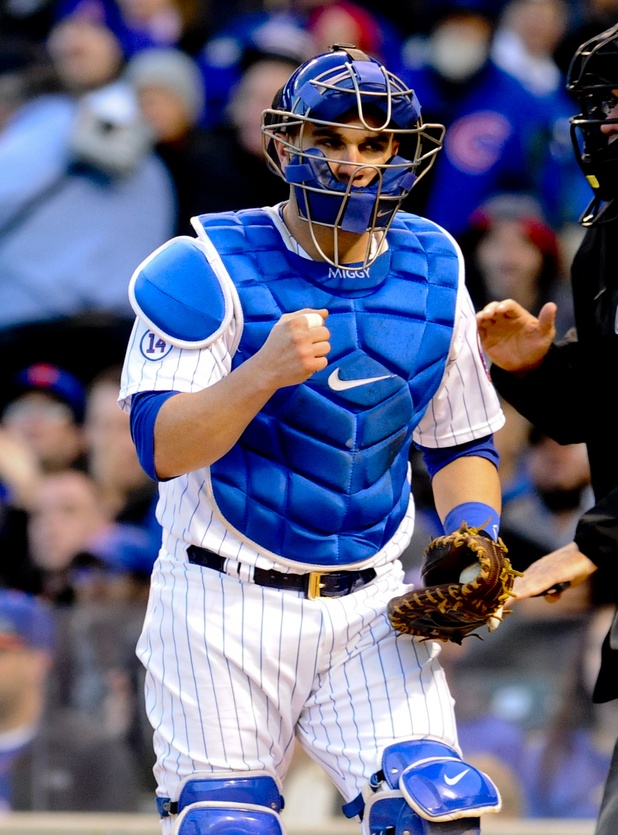Photo courtesy of Matt Marton-USA TODAY Sports
Miguel Montero doesn’t like to talk about his pitch-framing ability, which is strange, because it seems like he’ll talk about damn near anything else. It was never a secret that Montero, whom the Cubs acquired from the Diamondbacks in December, is an ebullient and exceptionally emotional guy. There were a handful of stories about the backstop heading into the season, and in most winters, a similar acquisition would merit even more coverage. With Jon Lester, David Ross, and such a unique collection of young players, though, Montero sort of blended into the noise.
However, it’s been harder to ignore him with each passing day into the season. Montero is hitting .313/.430/.500, in precisely 100 plate appearances. He’s struck out 19 times, but walked 17, and has launched four home runs. That kind of production won’t continue, but it’s not hard to imagine that Montero will match the production he gave Arizona at his peak, when he hit .284/.372/.454 in 2010 and 2011. That would still be All-Star-caliber work for a catcher.
What interests me most about Montero isn’t his leadership, or his apparent willingness to shout down a pitcher about the next pitch he should throw, or the kicks in the butt after walk-off wins, or #wearegood. It’s the beautiful juxtaposition of his old-school attitude with his extremely new-school skill set and profile. Here’s a guy who runs hard to first base after walks, because he doesn’t like to “pimp walks.” He’s a guy who doesn’t want to talk about framing, even though that statistical measurement of his defense is probably the reason the Cubs wanted him. He told readers of a mailbag feature recently that if he weren’t a baseball player, he might be a race-car driver. He hates not playing, which is why he caught 59 more complete games from 2011-14 than anyone else in baseball, despite missing a month of 2013 with an injury.
Yet, Montero is also a player who thrives on patience at the plate, as those 17 walks show. He’s also benefiting enormously from the additional rest Joe Maddon has assiduously given him. A year ago, he caught parts of 34 of the Diamondbacks’ first 37 games. He’d caught the complete game 32 times. In total, he was behind the plate for 291 1/3 innings. Through the Cubs’ first 37 contests this year, Montero has 21 starts behind the plate, 18 of them completed, and six appearances as a relief catcher. He’s seen only 197 innings of work. Part of Maddon’s plan has been platooning Montero with Welington Castillo, in addition to using David Ross as Jon Lester’s caddy. That’s led to Montero seeing only 10 plate appearances against lefties, after seeing 115 against them last year. If you’re wondering whether that’s a big deal, consider that Montero is a .273/.358/.442 career hitter against right-handed hurlers, but only hits lefties to the tune of .236/.298/.357.
Does it matter how fresh a guy is behind the plate, in terms of framing stats? Don’t tell Montero we’re talking about it, but I submit that it does. We know that a big part of being an effective framer is catching the ball quietly, head still, glove movement minimal, strong and motionless. That’s harder to do if your back is barking, harder to do if your nerves are frayed from the difficult task of doing this for four or five days in a row, harder to do if your forearm is begging for relief from the work of catching a sinker just below the knees in a way that makes it look like a strike. Indeed, Montero is a better receiver than he’s been since he was a much younger man:
Miguel Montero, Baseball Prospectus Catching Metrics, 2010-2015
| Season | Framing Runs Per 7000 Chances | Blocking Runs Per 7000 Chances | Receiving Runs Per 7000 Chances |
| 2010 | 20.2 | -4.2 | 16.0 |
| 2011 | 8.6 | 3.8 | 12.4 |
| 2012 | 10.6 | 8.6 | 19.2 |
| 2013 | 3.7 | -0.4 | 3.2 |
| 2014 | 12.2 | -1.3 | 10.9 |
| 2015 | 14.2 | 0.6 | 14.8 |
Being fresher and facing fewer bad matchups has allowed Montero to rediscover his terrific form of a few years ago. He’ll need to be used slightly more as the season progresses, especially because Castillo is likely to be trade fodder as spring muddles on into summer. He’s also bound to come back to Earth a bit, despite his relatively sustainable production profile. Still, it’s clear that the Cubs came into 2015 with a plan for revitalizing Montero, who was never the lost soul his statistics reflected. He was merely overused by Kirk Gibson in Arizona.
With better health and some young players on the brink of being ready to break through and reach the parent club, the Cubs should have some chances to replicate their experiment in the value of rest at other positions as the season progresses. In the meantime, Montero is an overwhelming success story so far, with the player, the front office and Maddon (whose embrace of the concept of keeping guys fresh was one reason I heartily recommended Montero as an off-season target) due equal measures of credit. On the field and off, both Maddon and Montero have been more than any Cubs partisan could have hoped for.
